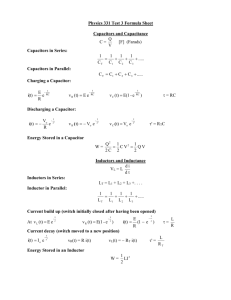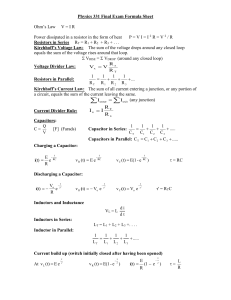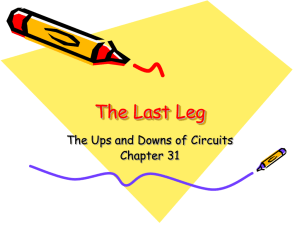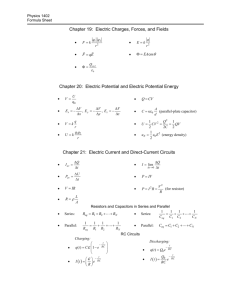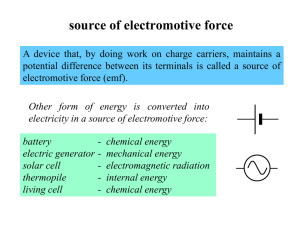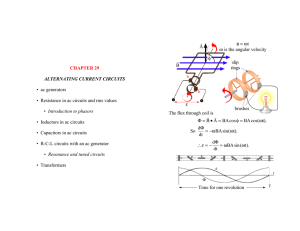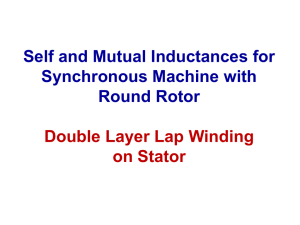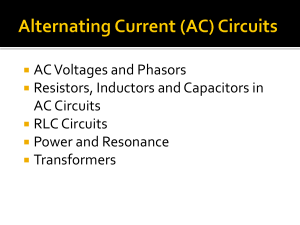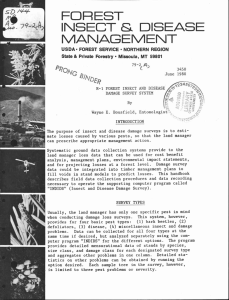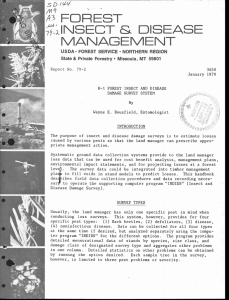Short Version : 28. Alternating Current Circuits
advertisement
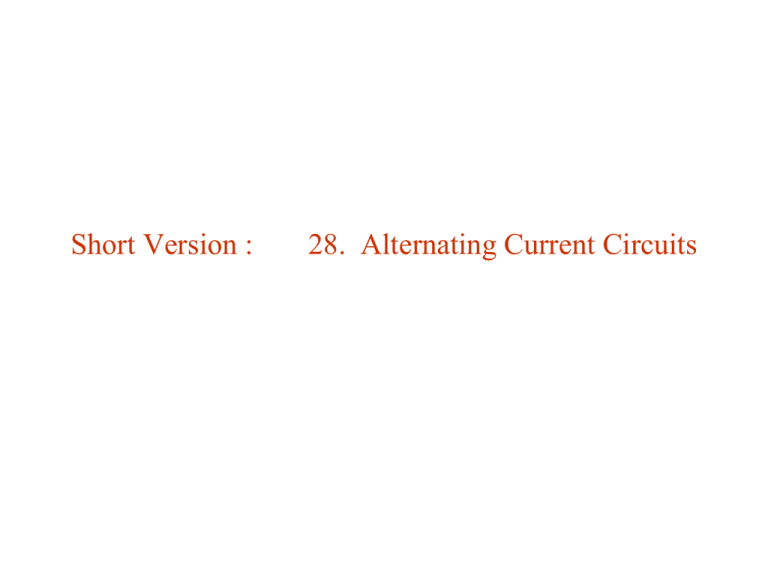
Short Version : 28. Alternating Current Circuits 28.1. Alternating Current Reminder: All waves can be analyzed in terms of sinusoidal waves (Fourier analysis Chap 14). Sinusoidal wave (Chap 13) : 1 2 Vp sin 2 1 2 sin x dx 0 2 Vrms 2 cos x dx 0 Vp I rms 2 Angular frequency : =/6 2 2 f V Vp sin t V = phase 1 2 Ip 2 [] = rad/s I I p sin t I Example 28.1. Characterizing Household Voltage Standard household wiring supplies 110 V rms at 60 Hz. Express this mathematically, assuming the voltage is rising through 0 at t = 0. 156 V V p 2 Vrms 2 f 2 60 Hz 377 s 1 V Vp sin t V t 0 0 0 0 V p sin V V p sin t 156 sin 377 t V 28.2. Current Elements in AC Circuits Resistors Capacitors Inductors Phasor Diagrams Capacitors & Inductors: A Comparison Displacing Functions g f g is moved to the right (forward) by to give f. f x g x x x sin cos Displacement: Phase: sin is cos moved forward by /2. sin lags cos by /2. sin x cos x 2 sin x cos x sin x 2 sin x dx cos x sin x 2 Derivative: moves sinusoidal functions backward by /2. phase is increased by /2. Integral: moves sinusoidal functions forward by /2. phase is decreased by /2. Resistors V t VR 0 V t Vp sin t I R R I + V p sin t I R 0 + VR I I p sin t I rms Vrms R Ip Vp R I & V in phase Capacitors When V(t) > 0 : V t VC 0 I + + VC V p sin t q C V t I C V p sin t d q C dV dt dt C V p cos t I C V p sin t 2 I peaks ¼ cycle before V I p C Vp XC q 0 C 1 C I leads V by 90 Vp XC Capacitive reactance XC X C as 0 DC: open ckt. X C 0 as HF: short ckt. Inductors When V(t) > 0 : V t EL 0 I + L + V p sin t L 1 I L V t d t I I peaks ¼ cycle after V d I Vp sin t dt L dI 0 dt Vp L sin t sin t L 2 Vp Ip Vp L XL L d t Vp L cos t I trails V by 90 Vp XL Inductive reactance XL X L 0 as 0 DC: short ckt. X L as HF: open ckt. Table 28.1. Amplitude & Phase in Circuit Elements Circuit Element Peak Current vs Voltage Ip Resistor Capacitor Inductor Ip Vp Ip Vp XC XL Vp V & I in phase R Phase Relation Vp 1/ C Vp L V lags I 90 V leads I 90 Example 28.2. Equal Currents? A capacitor is connected across a 60-Hz, 120-V rms power line, and an rms current of 200 mA flows. (a) Find the capacitance. (b) What inductance, connected across the same powerline, would result in the same current? (c) How would the phases of the inductor & capacitor currents compare? I rms C (a) Vrms (b) Vrms L I rms (c) C L I rms Vrms 200 103 A 120 V 2 60 Hz 4.42 106 F 4.42 F 120 V Vrms I rms 200 103 A 2 60 Hz Capacitor: IC leads V by 90. Inductor: V leads IL by 90. 1.59 H IC leads IL by 180. Phasor Diagrams Phasor = Arrow (vector) in complex plane. Length = mag. Angle = phase. V I X V leads I by 0. ( same phase ) V V e i V e it V leads I by 90. V leads I by 90. ( V lags I by 90 ) Capacitors Revisited I Vp e i t q CV + VC I C Vp ei t d q C dV dt dt I i CV CV e i C Vp i ei t 2 I leads V by 90 Taking the real part as physical V V p cos t I CV p sin t CV p cos t 2 Taking the imaginary part as physical V V p sin t I CV p cos t CV p sin t 2 V I Z Z 1 i C Impedance Inductors Revisited I Vp e V t EL 0 L i t I Vp + I L e V i L L it dt d I Vp e i t dt Vp i L V i 2 e L e it I lags V by 90 Taking the real part as physical V V p cos t V I p sin t L cos t L 2 Vp Taking the imaginary part as physical V V p sin t I Vp L cos t sin t L 2 Vp ZL L i Capacitors & Inductors: A Comparison C L translator: EB q B VI ZY Table 28.2. Capacitors & Inductors Defining relation Defining relation; differential form Opposes change in Energy storage Capacitor q C V I C dV dt V UE 1 CV2 2 Inductor L B V L I dI dt I UB 1 L I2 2 Behavior in low freq limit Open circuit Short circuit Behavior in high freq limit Short circuit Open circuit Reactance Admittance / Impedance Phase 1 / XC C XL L YC i C 1 / ZC ZL i L I leads by 90 V leads by 90 Application: Loudspeaker Systems Loudspeaker C passes High freq 1 Q R V IC R iC IC C V L d IL ILR dt i L R I L Loudspeaker system with high & low frequency filters. L passes low freq I V + 28.3. LC Circuits Analyzing the LC Circuit I V + U UB UE dU 0 dt q V C LI 1 1 L I2 CV2 2 2 dI dV CV dt dt dq I dt dV 1 d q dt C dt d q d2 q q 1dq 0L C d t d t2 C C dt d2 q q L 0 d t2 C q q p cos t 1 LC q dI L 0 C dt d I d2 q d t d t2 Resistance in LC Circuits – Damping I VC + + VR U L 1 1 L I L2 C VC2 2 2 dI d VC dU C VC I 2R L I dt dt dt + q VC C LI dVC I dt C dI I q I 2R 0 dt C I L dq dt dI q IR 0 dt C d2q dq q L 2 R 0 dt dt C q t q p e R t / 2 L cos t (see next page) Resistance in LC Circuits – Damping I VC + + VR L q dI I RL 0 C dt I dq dt + d2q dq q L 2 R 0 dt dt C q t q p e R t / 2 L cos t (see next page) Solutions to Damped Oscillator d2q dq q L 2 R 0 dt dt C Ansatz: 1 2 at L a R a q e 0 0 C q q0 e a t a L a2 R a 1 0 C 1 R 2L R2 4 q e R t / 2 L c ei t c e i t L R i C 2L 1 2L L 4 R2 C e R t / 2 L A cos t B sin t q0 e R t / 2 L cos t 4L R 2C R 2L 2 0 2 1 R LC 2 L 0 2 1 LC 28.4. Driven RLC Circuits & Resonance I + VR V I RL dI q 0 dt C + L + VC + V I R i d L I I i d C 0 1 V I R i d L C d Driven damped oscillator : Long time: oscillates with frequency d. Resonance if d = 0. 02 Z R i d L 1 2 d Resonance in the RLC Circuit 02 V I R i d L 1 2 d VL i d L I 02 VC VL 2 d VL VC V I R VC & VL are 180 out of phase. IC p VC p 1 / d C IL p VL p d L VL p VL p if 1 d C d L i.e., d2 02 Frequency Response of the RLC Circuit Series circuit same I phasor for all. VR in phase with I. VC lags I by 90. VL leads I by 90. 1 Q dI L V I R i L C dt iC 1 Z R i L C I R High Q Low Q Vp I p Z Z 1 R2 L C 2 See Prob 71 for definition of Q. tan VL p VC p VR p X XC L R At resonance, = 0. L R 1 C L 02 1 2 R Example 28.4. Designing a Loud Speaker System Current flows to the midrange speaker in a loudspeaker system through a 2.2-mH inductor in series with a capacitor. (a) What should the capacitance be so that a given voltage produces the greatest current at 1 kHz ? (b) If the same voltage produces half this current at 618 Hz, what is the speaker’s resistance ? (c) If the peak output voltage of the amplifier is 20 V, what will be the peak capacitor voltage be at 1 kHz ? (a) Greatest I is at resonance: C 1 L 2 0 2.2 10 02 1 LC 1 3 H 2 10 Hz 3 2 11.5 106 F 11.5 F (b) If the same voltage produces half this current at 618 Hz, what is the speaker’s resistance ? Vp I p Z Ip 2 Z 1 R2 L C 2 At resonance: Z R 2 Z Ip R 1 R2 L 2R C 1 1 1 1 3 2 618 Hz 2.2 10 H R L C 6 3 2 618 Hz 11.5 10 F 3 8.0 (c) If the peak output voltage of the amplifier is 20 V, what will be the peak capacitor voltage be at 1 kHz ? Peak voltage is at resonance (1 kHz). VC p I p X C Vp Vp I p R 20 V 1 1 8.0 2 103 Hz 11.5 106 F R C 35V Capacitor: I leads V by 90 , P = 0 28.5. Power in AC Circuits I p sin t PIV P Resistor: I & V in phase , P > 0 I p sin t p p sin t sin t I p V p sin t sin t I p Vp I p Vp I & V out of phase , P V V P sin t cos cos t sin sin t sin t 2 cos cos t sin t sin 1 I p V p cos I rms Vrms cos 2 Power factor Dissipative power = I2 R large power factor reduces I & hence heat loss. Conceptual Example 28.1. Managing Power Factor You’re chief engineer of a power company. Should you strive for a high or a low power factor on your lines? P I rms Vrms cos Power factor Generator : fixed Vrms . To maintain fixed <P>, Irms cos = const. Smaller power factor Ans.: higher Irms . higher power loss. keep power factor close to 1. Making the Connection Transmission losses on a well-managed electric grid average about 8% of the total power delivered. How does this figure change if the power factor drops from 1 to 0.71? P I rms Vrms cos To deliver the same power Transmission losses: I new 2 PL I rms R I 0.71 1.4 I PL , new 1.4 PL 2 2 PL ( doubles to 16% ) 28.6. Transformers & Power Supplies Transformer: pair of coils wound on the same (iron) core. Vsec ondary V primary N sec ondary N primary Works only for AC. Direct-Current Power Supplies Diode passes + half of each cycle Diode Diode cuts off half of each cycle RC (low freq) filter
